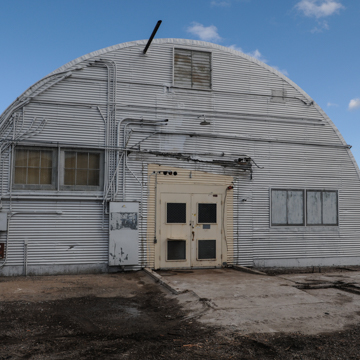You are here
Quonset Hut
Detonator research and development were carried out at the Trap Door Site in Technical Area 22. The Quonset Hut (TA-22-1) was erected here on its concrete pad in 1945.
Originally manufactured by the construction company of George A. Fuller, the Quonset Hut is a prefabricated structure that was deployed ubiquitously by the U.S. military during World War II. Assembled from sheets of corrugated galvanized steel on a framework of curved steel ribs, with plywood end walls, the building is characterized by its flexible, open plan and adaptability to a wide variety of functions. TA-22-1 was used for the final design and preassembly of the explosive components for the Fat Man bomb. Three bomb assemblies—designated F31, F32, and F33—left here in late July 1945, headed for Tinian Island in the Pacific by way of Kirtland Army Air Field in Albuquerque. On August 9, F31 was dropped on Nagasaki. The site’s name commemorates the fact that the design of the “trap door”—through which the plutonium core was inserted at the last minute inside the explosive sphere—was perfected here.
The Quonset Hut is eligible but not yet included in the Manhattan Project National Historical Park.
References
Los Alamos National Laboratory. The History and Legacy of the Manhattan Project at Los Alamos National Laboratory. Los Alamos, NM: Los Alamos National Laboratory, 2015.
McGehee, Ellen, Sheila McCarthy, Ken Towery, John Ronquillo, Kari Garcia, and John Isaacson. Sentinels of the Atomic Dawn: A Multiple-Property Evaluation of the Remaining Manhattan Project Properties at Los Alamos (1942–1946). Historic Building Survey Report No. 215. Los Alamos: Los Alamos National Laboratory, 2003.
National Park Service. Manhattan Project Sites. Special Resource Study/Environmental Assessment. Washington, D.C.: Department of the Interior, 2010.
Writing Credits
If SAH Archipedia has been useful to you, please consider supporting it.
SAH Archipedia tells the story of the United States through its buildings, landscapes, and cities. This freely available resource empowers the public with authoritative knowledge that deepens their understanding and appreciation of the built environment. But the Society of Architectural Historians, which created SAH Archipedia with University of Virginia Press, needs your support to maintain the high-caliber research, writing, photography, cartography, editing, design, and programming that make SAH Archipedia a trusted online resource available to all who value the history of place, heritage tourism, and learning.














